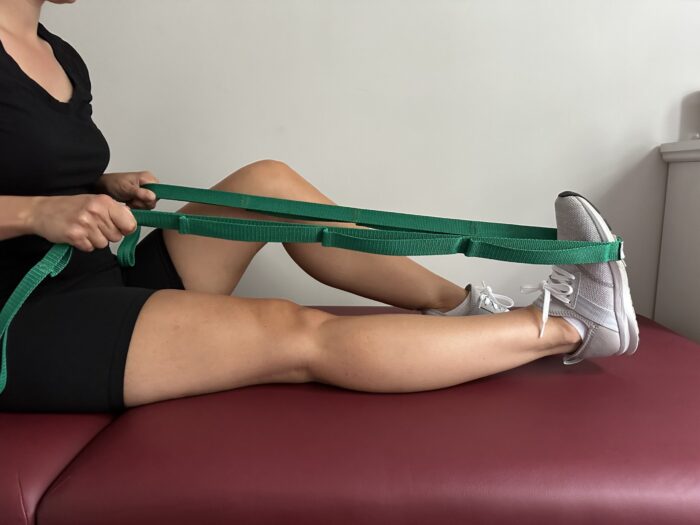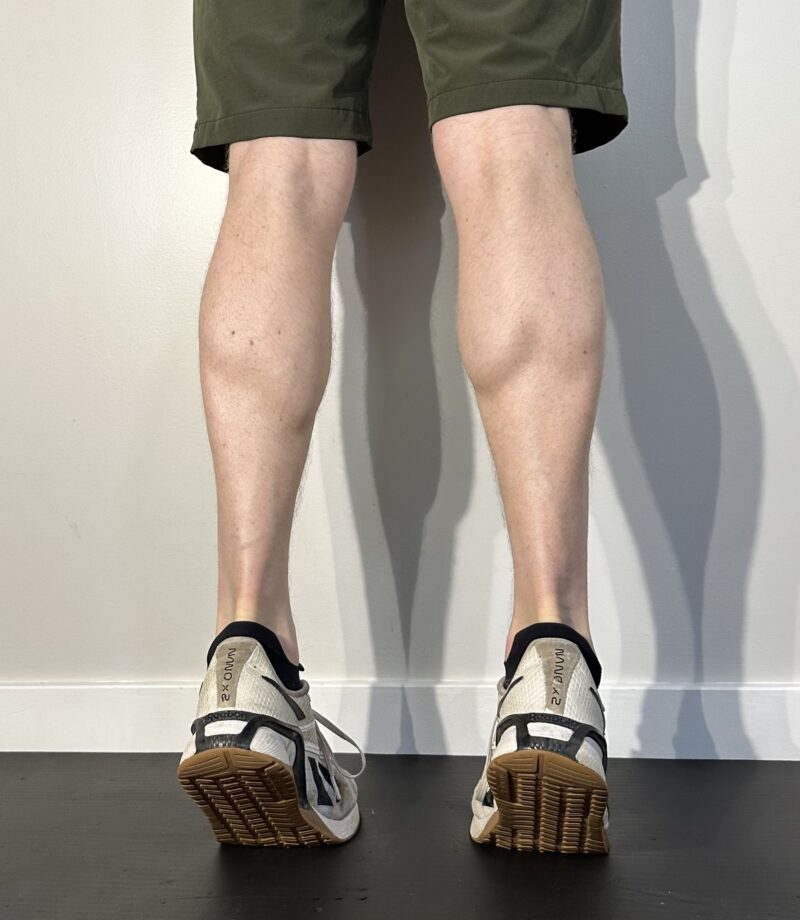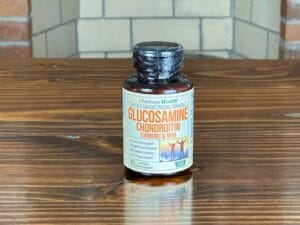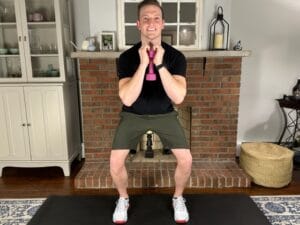Quick Guide: 6 Best Exercises Before Knee Replacement
1. Hamstring Stretch

- Stretches the hamstring muscle on the back of your thigh
- Improves the extension range of motion and straightening of your knee
- Keep your leg straight and lift off the table with a strap
- Hold this stretch for 20 seconds and repeat 5 times
- Best Stretching Strap in the link below
2. Calf stretch

- Stretches the calf muscle on the back of your lower leg
- Improves the extension range of motion and straightening of your knee
- Keep your leg flat on the table and pull your toes back toward your nose
- Hold this stretch for 20 seconds and repeat 5 times
- Best Stretching Strap in the link below
3. Heel Slides

- Stretches the quad muscle and patellar tendon
- Improves the flexion range of motion and bend of your knee
- Loop a strap around your foot and slide your heel toward your butt
- Hold this stretch for 10 seconds and repeat 10 times
- Best Stretching Strap in the link below
4. Heel/Toe Raises

- Strengthens the calf and shin muscles in your lower leg
- Improves ability to walk normally
- Raise up on your toes and then rock back on your heels
- Complete 15 repetitions and perform 2 sets
5. Mini Step-Up

- Strengthens the quad, glute, and calf muscles in your legs
- Improves ability to go up and down stairs
- Step up on the step and then back down, then repeat with the other leg
- Complete 10 repetitions and perform 2 sets
- Best Mini Stepper in the link below
6. Squat to Chair

- Strengthens the quad and glute muscles in your upper legs
- Improves ability to rise from a chair
- Stand close to a chair and slowly lower yourself down and then stand back up
- Complete 10 repetitions and perform 2 sets
Bonus: Helpful equipment for completing your knee replacement exercises

- Portable Massage Table provides a firm surface to complete exercises on
- It is lightweight and collapsible for easy storage
- You no longer have to worry about getting up and down from the floor
- It is helpful both before an after your knee replacement surgery
- Best Portable Massage Table in the link below
Disclaimers and Disclosures: All information in this article is for informational and educational purposes only and should not be taken as individual medical advice. Additionally, this article contains affiliate links, meaning when you make a purchase, we make a small commission at no additional cost to you. For more information, see our full Disclaimers and Disclosures.
Are you looking for the best exercises to do before your knee replacement surgery?
If you have been dealing with knee pain that requires a knee replacement and are looking for the best exercises to be doing before surgery, then you’re in the right place! Undergoing a knee replacement is no easy feat, and it is extremely smart of you to be preparing for your surgery. Studies show the best way to prepare for your knee replacement surgery is with the proper exercises that will help maximize your recovery afterward. It is my goal to be there for you and give you the best exercises to be doing leading up to your knee replacement surgery.
As a physical therapist with over 10 years of experience, I have seen thousands of patients that are in need of a knee replacement. Because of this, I have created an exercise program specifically designed to address the deficits that are present leading up to this procedure. I have included the most important exercises before knee replacement surgery to help you heal and recover faster.
In this article, I will give you an in-depth description of all the exercises you need to be doing before your knee replacement and how to perform them. Additionally, I will provide you with the best equipment that we use in the clinic to do each of these exercises.
If you really want to maximize your recovery, then take a look at the best exercises to be doing after your knee replacement as well. If you’re looking to get started right away, then check out our quick guide to the best exercises before knee replacement directly above, and then scroll later in the article for an in-depth description of how to perform them.
What are the best at home physical therapy exercises before knee replacement surgery?
The best physical therapy exercises before a knee replacement are the hamstring stretch, calf stretch, heel slides, heel/toe raises, mini step-ups, and squat to a chair. These exercises should be completed 1-2 times per day leading up to your knee replacement surgery.
1. Hamstring Stretch

How to perform the hamstring stretch with a strap exercise before a knee replacement.
Start by lying on your back with both legs straight and the strap around the middle of your foot. Keep your knee straight and use the strap to pull your leg straight up until you feel a stretch in the back of your leg. Once you feel the stretch, hold it for 20 seconds and then lower back down to the start position. Rest for a second or two and repeat this 5 times.
Professional tip: “Having a slight bend in your knee is ok to start out. But as your body gets used to this stretch, you should work to keep your knee as straight as possible”.
What is the best equipment for the hamstring stretch with a strap exercise?
The Stretch Out Strap is the best option for several reasons. It is 6 feet long and has multiple loops and handles all along its length, so it is good for people of different sizes and allows you to get the most comfortable grip. It is also very durable and we have had thousands of patients use it in our clinic and most of them end up buying one for their own use at home. The Stretch Out Strap can be found in the link below.
2. Calf Stretch

How to perform the calf stretch with a strap.
Start by lying on your back with your leg straight and the strap around the ball of your foot. Keep your knee straight and pull your foot and toes back toward you by pulling on the strap. Once you feel the stretch in the back of your leg, hold it for 20 seconds and repeat 5 times.
Professional tip: “If you can’t feel the stretch at first, actively pull your toes toward your nose first, and then give extra pressure by pulling on the strap”.
What is the best equipment for the calf stretch with a strap?
The Stretch Out Strap is also the best option for this stretch as well. It has great utility and can be used for over 20 different stretches that we commonly have patients perform. There is also a version of this strap that is about a foot longer, the Stretch Out Strap XL, and it works well for people taller than 5’10’’. The Stretch Out Strap can be found in the link below.
3. Heel Slides

How to perform the heel slides with a strap exercise before knee replacement.
Start lying on your back with the strap around the middle of your foot. Try to relax your leg and slowly pull on the handles of the strap so your knee bends and your heel slides up toward your butt. Keep pulling until you feel a stretch across your knee. Once you feel the stretch hold it there for 10 seconds then return to the start position and repeat 10 times.
Professional tip: “I usually tell people this exercise is most people’s least favorite due to the discomfort associated with it. So if you’re feeling this discomfort then you’re in good company. This is normal, but we want it to be tolerable and the pain should go away very quickly when you’re done with the exercise”.
What is the best equipment for the heel slides with a strap exercise?
The Stretch Out Strap, once again, reigns supreme. It is 6 feet long and has multiple loops and handles all along its length, so it is good for people of different sizes and allows you to get the most comfortable grip. It is also very durable and we have had thousands of patients use it in our clinic and most of them end up buying one for their own use at home. The Stretch Out Strap can be found in the link below.
Also, we want your heel to slide with as little friction as possible. If you’re doing this exercise on your hardwood floors with socks on, then consider this pretty frictionless. However, if you’re exercising on a massage table, on a couch, or in your bed then using a slide board can be helpful to make this exercise nice and smooth. We use the slide board for our patients in the clinic when they’re on the mat tables and need a smooth surface. The Slide Board can be found in the link below.
4. Heel Raise/Toe Raise

How to perform the heel raise/toe raise.
Start standing in front of your counter or another stable object you can hold on to. Slowly raise your heels off the ground so you are standing on tip toes, then return to the start position. Then raise your toes off the ground so you are standing on your heels, then return to the start position. Repeat both of these actions 15 times, take a 30 second break, and perform 2 sets.
Professional tip: “It’s ok to gently rock forward when you go on your toes and back when you go on your heels, but try to stay standing nice and tall the whole time without too much forward and backward motion”.
5. Mini Step-Ups

How to perform the mini step-up exercise before knee replacement.
Start by placing a small step perpendicular to your counter or other stable surface. Hold on to the counter with one hand and step up on the platform with your unaffected leg, then bring your affected leg up on the platform. Return back to your start position by stepping backward in the same sequence.
Once you have completed 10 step-ups leading with the unaffected leg, then perform 10 repetitions leading with the affected leg. Take a 30 second break and perform 2 sets with each leg.
Professional tip: “Start with a 4-inch step height when you begin this exercise. Once you can perform all the repetitions without pain and with relative ease, increase the step height by 2 inches. A normal height step is 8 inches, so I have my patients work toward this goal”.
What is the best equipment for the mini step-up exercise?
For this exercise, you will want a stepper that is adjustable and that has good traction. The stepper below is nonslip and allows for variable heights so you can progress as you get strong and feel better. These are the same steppers we use in the clinic, so I know they are durable and work well. The Stepper can be found in the link below.
6. Squat to a Chair

How to perform the squat to a chair exercise before knee replacement.
Start by standing in front of a chair with a foam pad in it to increase the height. Slowly sit your butt back and control your descent so you do not plop down. Then, without using your hands, stand back up to the start position. This counts as one repetition. Perform 10 repetitions, take a minute break, and complete 2 sets.
Professional tip: “Start with a foam pad in the chair to increase the height of the target, which makes it easier to stand up and sit down. Once you can complete all repetitions, then remove the foam pad so it is a normal height chair”.
What is the best equipment for the squat to a chair exercise?
A firm balance pad is perfect due to its utility. It’s firmer than a pillow, so you don’t sink down into it. Also, this is exactly what we use in the clinic to raise the height of the chair and make this exercise a little easier. Then, once you have gained enough strength, get rid of the foam pad and just do the squats to the height of a normal chair. But keep the pad and use it for balance exercises in the future, which will help reduce your risk of falls.
Best Exercises Before a Knee Replacement Final Thoughts
After reading this article I hope that you now feel a little more confident about having to undergo a knee replacement. Many of my patients are often nervous and a little stressed about having to get their knee replaced. However, the good news is that this procedure has a great success rate and once it is all said and done, well over 95% of my patients report being pleased that they went through with it.
I like to remind my patients that their knee replacement journey is a marathon, not a sprint. So getting started early with these exercises before your knee replacement is an important step. Make sure to be diligent with them for better outcomes after surgery. Then be sure to be even more diligent with your exercises after your knee replacement.
Although it is rare, one of the leading complications after a total knee replacement is arthrofibrosis or an overly stiff knee joint. The best way to prevent this complication is to consistently perform your exercises and be an overachiever. If you do end up with a stiff knee, then we have you covered with our exercises after a knee manipulation.
Another good way to prevent complications with a total knee replacement is with proper supplementation and vitamins. With all of this information, you now have everything you need for a successful outcome after surgery. Take it one day at a time and I have full confidence you are ready for this journey and you will do great!
Why trust Physical Therapy Simplified for exercises after knee manipulation?
At Physical Therapy Simplified, our mission is to provide an easily accessible and highly reputable source of physical therapy information that anyone can understand, follow, and benefit from. We want you to feel confident that you are getting the best content and information that will help to reduce your pain and restore you to your highest functional potential.
The author of this article, Andrew Harkins, DPT, has demonstrated expertise in the field of physical therapy and is certified by the American Board of Physical Therapy Specialities as an Orthopedic Clinical Specialist. He has over ten years experience as a licensed physical therapist and is an expert in treating conditions related to the knee.
Andrew has worked as a teaching assistant at the University of Pittsburgh in their Doctor of Physical Therapy Program. Specifically, due to his expertise in treating knee conditions, he assisted in musculoskeletal coursework and provided instruction on how to treat patients before their knee replacement surgery.


